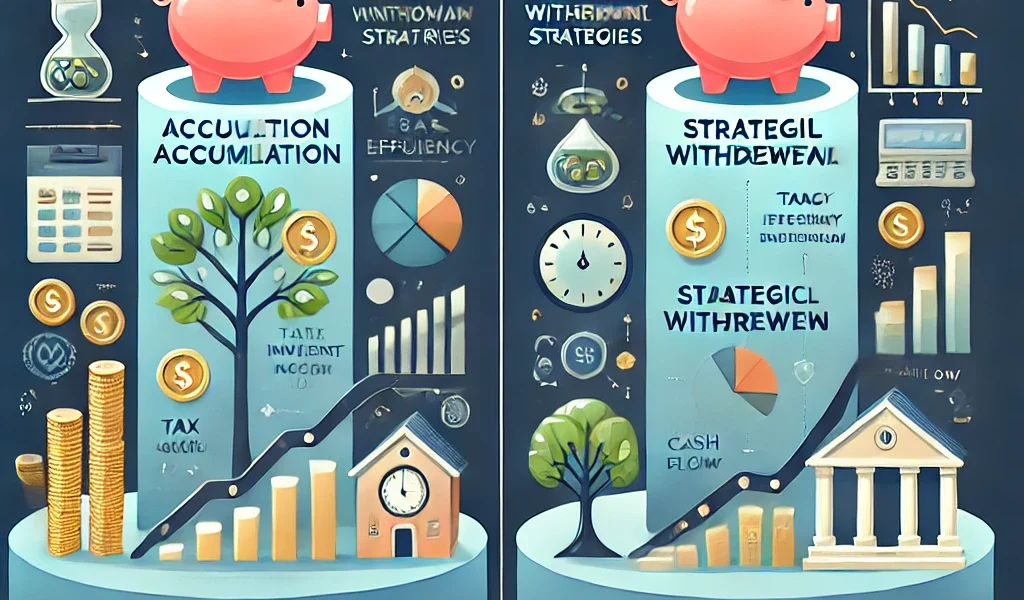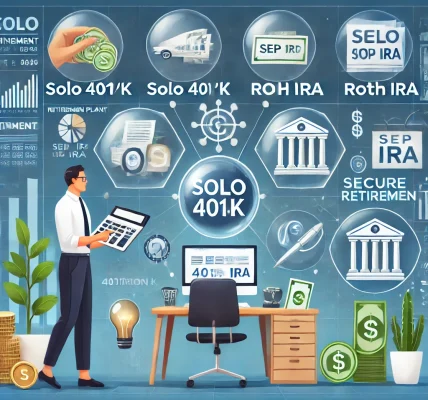How to Transition from Accumulation to Distribution in Retirement Plans: Which One Offers the Best Returns?
Introduction
Retirement planning is a two-phase journey:
- Accumulation Phase – When you save and grow your investments.
- Distribution Phase – When you start withdrawing your retirement savings.
While many people focus on saving for retirement, fewer pay attention to how they will effectively withdraw their savings to ensure financial security. A poor distribution strategy can lead to higher taxes, premature depletion of funds, or inefficient wealth transfer.
In this guide, we’ll cover:
✔ How to transition from accumulation to distribution
✔ Key withdrawal strategies to maximize returns
✔ How to minimize taxes and penalties
✔ The best retirement income sources
✔ Mistakes to avoid when withdrawing money
By the end, you’ll have a clear strategy for ensuring a financially secure retirement.
Understanding the Accumulation and Distribution Phases
✅ Accumulation Phase – Building Wealth
✔ Investing in 401(k)s, IRAs, stocks, mutual funds, and real estate
✔ Maximizing employer contributions and tax-deferred growth
✔ Reinvesting dividends and capital gains
✔ Balancing risk vs. return based on time until retirement
✅ Distribution Phase – Withdrawing Wisely
✔ Strategic withdrawals to avoid running out of money
✔ Managing tax implications of different account types
✔ Ensuring sustainable cash flow for living expenses
✔ Protecting savings from market downturns and inflation
💡 Key Takeaway: A solid distribution strategy is just as important as a strong investment plan.
Key Retirement Withdrawal Strategies
1. The 4% Rule – A Safe Withdrawal Rate?
✔ Withdraw 4% of your portfolio annually in retirement
✔ Adjust for inflation each year
✔ Historically, this rule allows savings to last 30+ years
Example:
- If you have $1,000,000 in savings, you withdraw $40,000 in the first year
- Adjust for inflation, so in the second year, you might withdraw $41,200 (if inflation is 3%)
🟢 Pros: Simple, time-tested approach
🔴 Cons: Doesn’t account for market downturns or changing spending needs
2. Bucket Strategy – Segmenting Your Funds
✔ Divide your savings into three buckets:
1️⃣ Short-Term (0-5 years) – Cash, CDs, bonds for stability
2️⃣ Mid-Term (5-15 years) – Balanced funds, dividend stocks
3️⃣ Long-Term (15+ years) – Growth stocks, real estate
🟢 Pros: Provides security while allowing long-term growth
🔴 Cons: Requires active management
3. Required Minimum Distributions (RMDs) – Managing Tax Implications
✔ RMDs are mandatory withdrawals from Traditional IRAs, 401(k)s (starting at age 73 in 2024)
✔ Failing to withdraw leads to 50% tax penalty
Tip: Convert some Traditional IRA funds into a Roth IRA before RMDs begin to avoid tax burdens.
🟢 Pros: Prevents excess taxes on unused retirement funds
🔴 Cons: Can push retirees into higher tax brackets
4. Social Security Optimization – Delaying for Maximum Benefits
✔ You can claim Social Security benefits as early as 62, but delaying increases your monthly benefit:
✔ Claim at 70 instead of 62 → 32% higher monthly benefits
Example:
- Claim at 62 → Receive $1,500 per month
- Claim at 70 → Receive $2,600 per month
🟢 Pros: Provides guaranteed income, inflation-adjusted
🔴 Cons: Delaying requires alternative income sources
How to Minimize Taxes on Withdrawals
✅ 1. Prioritize Tax-Free Withdrawals First
✔ Use Roth IRA withdrawals first (tax-free)
✔ Delay withdrawing from Traditional IRAs & 401(k)s to minimize tax burden
✅ 2. Utilize Tax Brackets Wisely
✔ Withdraw only enough to stay in a lower tax bracket
✔ Spread large withdrawals over multiple years
Example: If you withdraw too much in one year, you might enter the higher 24% tax bracket instead of 12%.
✅ 3. Convert to a Roth IRA Before Retirement
✔ Roth IRA withdrawals are 100% tax-free
✔ Converting before retirement helps avoid higher RMD taxes later
Best Retirement Income Sources for a Sustainable Future
| Income Source | Taxable? | Benefits | Best For |
|---|---|---|---|
| 401(k) / Traditional IRA | ✅ Yes | Pre-tax growth | Long-term savings |
| Roth IRA | ❌ No | Tax-free withdrawals | High-growth investments |
| Social Security | ✅ Yes (partially) | Inflation-protected income | Guaranteed lifetime income |
| Pensions | ✅ Yes | Stable income | Former government/corporate employees |
| Dividends & Stocks | ✅ Yes (lower rate) | Passive income | Diversified portfolio |
| Real Estate Rentals | ✅ Yes | Rental cash flow | Property investors |
💡 Best Strategy: Diversify income sources to balance growth, security, and tax efficiency.
Common Mistakes to Avoid in Retirement Withdrawals
🚫 1. Withdrawing Too Much Too Soon
✔ Over-withdrawing can lead to early depletion of retirement funds.
🚫 2. Ignoring Tax Implications
✔ Without tax planning, large withdrawals can trigger higher tax rates.
🚫 3. Underestimating Inflation
✔ A $50,000 retirement income today might only be worth $35,000 in 20 years.
✔ Invest in inflation-protected assets (TIPS, real estate).
🚫 4. Forgetting About Healthcare Costs
✔ Medicare doesn’t cover long-term care – consider Health Savings Accounts (HSAs).
🚫 5. Not Adjusting for Market Conditions
✔ In a bear market, withdrawing fixed amounts can deplete savings faster.
✔ Reduce withdrawals during downturns.
Which Withdrawal Strategy Offers the Best Returns?
| Strategy | Best For | Growth Potential | Risk Level |
|---|---|---|---|
| 4% Rule | Simple planning | Moderate | Low |
| Bucket Strategy | Diversified savings | High | Moderate |
| RMD Approach | Tax-efficient planning | Moderate | Low |
| Delaying Social Security | Maximized benefits | High | Low |
💡 Best Approach: Combine multiple strategies to ensure stable cash flow, tax efficiency, and long-term growth.
Final Thoughts: Creating a Smooth Transition to Retirement
✔ Moving from accumulation to distribution requires careful planning.
✔ A mix of withdrawal strategies, tax planning, and diversified income sources helps maximize financial security.
✔ Avoid common mistakes like over-withdrawing, ignoring taxes, and underestimating inflation.
💡 Key Takeaway:
A well-planned withdrawal strategy ensures your retirement funds last for decades, providing peace of mind and financial freedom.
Disclaimer:
This blog is for informational purposes only and does not constitute financial or legal advice. Please consult a financial advisor for personalized guidance.




